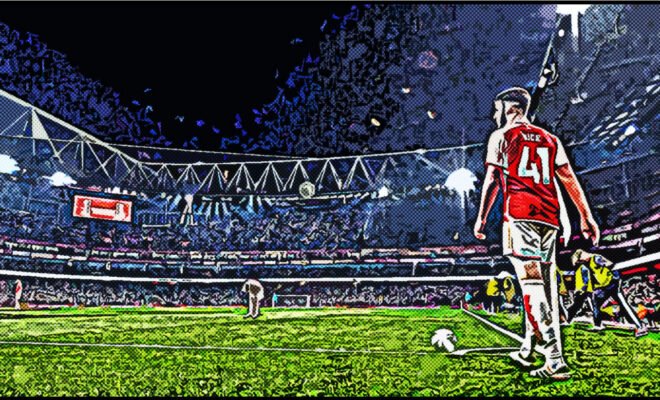Arsenal’s “Negative Play” Is Just Grown-Up Winning

Call it what you want. Pragmatic. Industrial. “Negative.” The reality is simple. Arsenal looked like a title team in 22/23 a year or two ahead of schedule. That reset the league. By mid-23/24, opponents adjusted. The league tilted toward mid- and low-blocks, compressed penalty areas, and games decided by duels. Arsenal adapted. That is not fear. That is intelligence.
Evolution: The 22/23 Rise and What It Unlocked
In the 2022-23 season, Arsenal’s ascendancy surprised many. They pressed, they possessed, they attacked with structure. Because they were ahead of where many expected them to be, opponents had the time and headspace to prepare for them. The result: more teams sitting deeper, refusing to allow high-tempo, expansive play. When you routinely pin teams back, they learn to defend the deep third.
That third can feel like a vacuum of creativity. When the central channels are clogged, when everyone behind the ball has rehearsed the same movements, instinctive combinations from open play become harder. A possession lead no longer guarantees openings. Arsenal earned territory, but big openings became fewer.
In short: Arsenal’s early trajectory forced the league to figure them out early. That’s a double-edged sword. On one hand it signals you’ve arrived; on the other it signals you must evolve faster or stagnate.
Response: Control, Territory, Then Margins
Arsenal’s answer: double down on territory, dominate structurally, then exploit the margins when the perfect opening doesn’t appear. They still prefer to play expansively when opponents open up, but they no longer operate only in that ideal world. The world shifted. So did they.
They ask: how do you win when the opponent backs in, defends the box, allows possession but limits penetration? They force mistakes. They force restarts. They convert set-pieces. The logic is straightforward. Your possession doesn’t always yield clean chances. But possession can force the opponent to make decisions: when to press, when to clear, when to risk stepping. That produces unfinished sequences. That produces corners, throw-ins, free kicks.
And what you do with those second-phase chances matters. That’s where structural advantage meets rehearsal. Enter the set-piece layer.
Evidence: Stats, Trends and Tactical Shifts
Start with the numbers. In the 2023-24 Premier League season Arsenal scored 20 set-piece goals, the most in the division. Sixteen of those came from corners, matching the single-season record. Since the start of 2023-24, Arsenal have scored 33 goals from corners, whereas no other Premier League side has more than 20 in the same span. One independent breakdown put Arsenal’s set-piece goals at 30 since 2023-24, equating to roughly a quarter of their league goals in that period. Meanwhile the league context is clear: the overall proportion of goals coming from set-pieces has risen to around 19 percent for the league as a whole. So Arsenal are getting a largest share of this slice of pie? That’s tactical intentionality, not luck.
Then there is Arteta’s quote from October 2023:
“A lot of teams are defending with low blocks, so open play is one thing, but set-pieces aren’t something very different to the game. It’s something that is connected.” That admission reveals the strategic calculation. When the ramparts go up, you change the front-door approach and master the windows.
On the defensive side this also holds: Arsenal conceded only 29 league goals in 2023-24 while scoring 91, their highest ever in the competition. But there is a nuance, while they dominate open play, set-piece defence remains one of their only weak spots. For the 2024-25 season they conceded 12 goals from set-pieces, which equated to almost 40 percent of their goals conceded. That speaks of a trade-off: if you dominate open play and force restarts, some of those restarts you will face too. It is part of the price paid for playing the game their way.
Set Pieces: From Fallback to Tactical Frontier
In many teams set pieces are fallback. At Arsenal they became a planned frontier. Why? Because possession and territory still matter. The difference: you don’t wait for breakdowns purely by luck; you engineer them. You force the clearance, the block, the corner. Then you execute. Set-piece coach Nicolas Jover’s arrival allowed the layering of routines. Multiple deliveries, decoy runs, blockers, screens. Clean, rehearsed choreography.
When a low-block opponent sits behind their lines, you gain territory, you probe, you cycle possession. But if they refuse to open up, you still win without needing open-play brilliance. You win via repetition. Arsenal certainly still aim to break teams open in play, but when those cracks don’t appear you switch gear. That’s maturity.
Examples abound: Arsenal scored 11 goals from set-pieces this season. They reached 20 set-piece goals across the 2024 calendar year, equaling a club record from 2009. This isn’t chance. This is rehearsal.
Set pieces also provide structural predictability: you can train them, schedule them, analyse opponent weaknesses. They exist outside the chaos of open play. For a team built on control and structure, they fit perfectly.
Tactical Intelligence, Not Retreat
Critics will call set-piece reliance “negative.” They’ll say “we’d rather you broke teams down in open play.” Fine. But if you pin a team for 70 percent of possession, force them to clear under pressure, manufacture ten corners, and then score twice from them, you aren’t retreating. You are controlling. You are exploiting.
Compare to other elite clubs. Some remain able to rely heavily on open-play brilliance. But if you play a team that sits deep, it becomes about patience and dead-ball moments. Arsenal acknowledged that shift. Their first wave of rise forced the game to adapt, which forced them to adapt again. That cycle is normal among elite clubs. Historically, teams that win repeatedly don’t just have assets; they evolve when others adjust. Barcelona shifted from pure tiki-taka into versions that accepted other traits. Atletico Madrid under Simeone mastered the small margins. Arsenal are on that same path. They were the high-tempo, expansive side that generated territory early; now they are also the side that maximises the restart and controls the restart.
You still see expansiveness when the opposition opens the game. But that is no longer the primary crutch. When the opposition refuses to open, Arsenal don’t retreat into panic. They remain structured. They accumulate chances via pressure. They force restarts. Then they finish. That is tactical depth, not limitation.
Why This Matters
In the Premier League, where every point counts and every opening is squeezed, fine margins decide everything. Possession alone doesn’t guarantee goals. High pressing alone doesn’t guarantee superiority. Ownership of territory does, but what you do when the open play stalls is critical.
Arsenal’s strategy acknowledges that opponents adapt. It acknowledges that open play is contested. It acknowledges that control often yields resets, not open chances. It answers the question: if you cannot always break teams in play, how do you still win? The answer: you convert the second move, the dead ball, the restart.
That approach is less glamorous. It lacks the flash of a 30-pass move through lines. But it is realistic. It is modern. It is effective. And it shows a side thinking beyond possession stats and expected goals alone. They are thinking about the opponent, the season, and the sequence of matches.
Conclusion: Not Retreat, But Mastery
Call it “negative play” if it makes you feel better. The tape and the data say something else. Arsenal evolved from flair to control without losing the ability to cut teams open. They added a ruthless restart layer because the league forced the issue. In a cycle defined by fine margins, choosing to own those margins is not a compromise. It is how you win.
Arsenal’s tactical evolution is not about shrinking. It is about expanding their winning toolkit, possession, structure, restarts, and variety. If your opponent refuses to open, you still win. If they open, you still can dazzle. That duality is what separates pretenders from contenders. And Arsenal have learned that.
Leave a reply
You must be logged in to post a comment.






